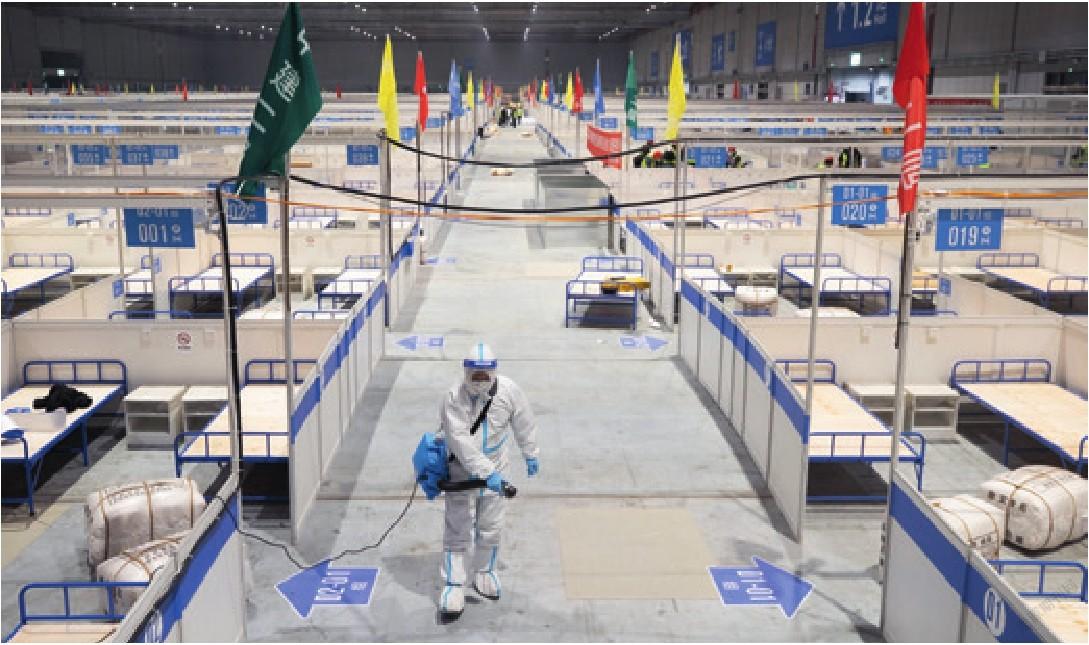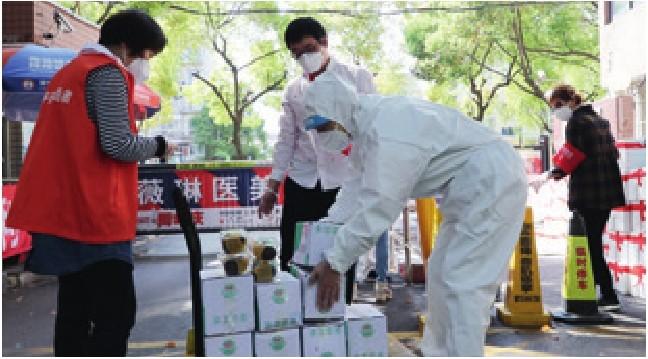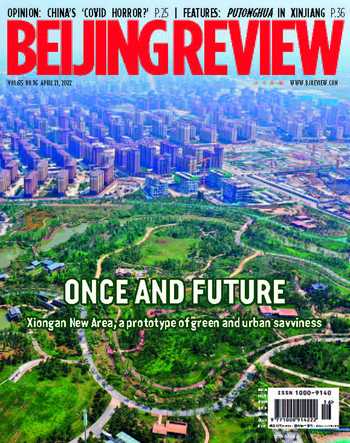The Conscious Choice
2022-04-21ByTaoXing
By Tao Xing
Shanghai, the economic powerhouse of China, is now the country’s major battlefield against COVID-19. The worst flare-up nationwide since the early days of the pandemic has put the city in a hard place.
As of April 13, the city had seen 14,471 confirmed local cases since early March, with 6,646 cured, 7,818 treated in hospital, and seven fatalities; 25,141 local asymptomatic infections remained under medical observation. The city, with a population of over 25 million, has been under lockdown since March 28.
Shanghai was previously seen as a prime example of epidemic prevention and control courtesy of its excellent data-based tracing system, swiftly and precisely locating any close contacts and sealing off smaller areas to prevent the virus’ further spread. But this time, the Omicron variant has a stronger transmission capacity with a higher proportion of asymptomatic carriers going under the radar, making it more difficult to detect in the early stages of infection.
Insufficient preparations and underestimated risks had led to the current situation, Ma Chunlei, Secretary General of the Shanghai Municipal Government, said at a press conference on March 31.
Tracing capability needs vast improvement when dealing with Omicron, and only swifter action can avoid community transmission, experts said.
The virus has widely spread among Shanghai’s local societies. As the average incubation period for the Omicron variant is only three days, an infected person might not even test positive in the first two days, according to Wu Zunyou, chief epidemiologist at the Chinese Center for Disease Control and Prevention.
Repeated citywide nucleic acid testing is necessary to end the current resurgence as soon as possible, Wu said on social media on April 7, stressing that those who are infected, but test negative, might infect others if not identified immediately during the following screenings.
Both the Wuhan lockdown in Hubei Province two years ago and the one in Xi’an, Shaanxi Province, earlier this year produced problems like food supplies running low. And Shanghai residents faced a similar predicament immediately after the stay-athome order took effect.
Shanghai has sufficient goods; the problem lies in the logistics, Cui Lili, Director of the Institute of E-Commerce with the Shanghai University of Finance and Economics, told Beijing Review.
“Group buying community leaders” have therefore taken on a significant role in all of the megacity. Thanks to these people, their communities can get enough food in from the outside. These “leaders” are usually young adults who are either very familiar with e-commerce or who come with solid food-buying resources.

Since March 31, Cui, the leader of her community, together with her counterparts of a further 148 communities, has purchased over 15,000 kg of vegetables, 4,000 kg of rice, 15,000 kg of flour and noodles, 10,000 kg of fruit, 1,000 kg of meat, 70,000 eggs, and many more daily necessities for residents.
“Because of my previous research programs, I have direct connections with a number of farms and food manufacturers,” Cui said. Due to the absence of third-party logistics services during the lockdown, the producers usually distribute the goods themselves, according to her.
When orders reach the community, its workers and volunteers then deliver everything to residential doorsteps, Zhang Fangyi, marketing manager of a Shanghai-based foreign cosmetics company, told Beijing Review.
“For food supplies, what the government should do, is to ensure logistics companies can remain fully operational,” Yin Zhi, a professor of urban planning at Tsinghua University, told Beijing Review in an interview in January.
With improvements underway, the municipal authorities confirmed on April 10 that e-commerce giants like JD.com, online food delivery platforms Meituan and Ele.me, and courier service companies had been increasing their capacity to provide residents with daily essentials.
Help also floods in from all corners of the nation. Different regions and the People’s Liberation Army have dispatched roughly 40,000 medics to assist with Shanghai’s containment efforts, in addition to donating anti-epidemic supplies and daily essentials.
“In general, Shanghai failed to predict the consequences of lockdown caused by this resurgence in the earliest of stages,” Cui suggested. “We have experienced Wuhan, Xi’an and now Shanghai’s lockdown disorder and distress; it’s necessary for cities to draft better emergency plans that can tackle the worst case scenarios.”
Despite interrupted land transportation due to epidemic curbs, Shanghai has maintained roundthe-clock operations as an international shipping center and an air freight, postal and rail services hub. Moreover, as the city with the largest concentration of financial markets globally, it has also managed to ensure their infrastructure runs smoothly and transactions are secure.
Still, the lockdown has inevitably landed many individuals in a tough spot. According to Zhang, her recent sales and income have decreased significantly. “We cannot receive products, and we cannot dispatch them to our partners outside Shanghai.”
The issue has received government attention. A Ministry of Transport circular issued on April 12 prohibited the blocking of road transportation, irrespective of their circumstances, and ordered the arrangement of more efficient COVID-19 screening along transportation routes.

China now grapples with its biggest COVID-19 challenge since the first peak in infection numbers in early 2020. The Chinese mainland reported 325,303 cases from March 1 to April 11, across 30 provincial-level regions, according to the National Health Commission (NHC).
China will adhere to its dynamic zero-COVID approach as local infections are on the rise, according to NHC spokesperson Mi Feng on April 6. With the overarching goal of preventing imported infections and domestic flare-ups, the policy means that when a new local outbreak occurs, measures will be taken to promptly stem the spread of the virus and clear all cases.
Nevertheless, news about difficult access to food supplies and medical services, some with fatal outcomes, has sparked much public debate on the current approach. The “Omicron is just a big flu with a low death rate” hashtag recently made the online rounds, leading some to call for the easing of COVID-19 restrictions.
Omicron is not a “big seasonal flu,” and will severely impact the unvaccinated or not fully vaccinated elderly, Zhang Wenhong, who heads Shanghai’s COVID-19 expert panel, said during a press conference on April 9. The current dynamic zero-COVID strategy is to protect those most vulnerable in pandemic times, according to him.
According to data from the UK and the U.S., the Omicron variant caused more deaths than the previous Delta variant—if tallied over the same period, Wu said at a press conference on April 6.
He explained that the Chinese mainland has a low COVID-19 mortality rate due to early detection and quarantine measures limiting the outbreak, preventing it from creating a spike of infections which might in turn strain the medical system.
Nearly 1.24 billion out of 1.41 billion people across the Chinese mainland had been fully vaccinated against COVID-19 as of March 24. “The vaccination rate has built up effective virus-resistance, which can reduce symptoms and even eliminate them altogether,”Liang Wannian, head of the NHC COVID-19 leading task force, said on April 10.
Wang Guiqiang, an advisor to the NHC and Director of the Infectious Diseases Department at Peking University First Hospital, referred to the 0.7 percent mortality rate in Hong Kong Special Administrative Region (HKSAR), much higher than that of the “standard” seasonal flu, normally at 0.01 percent.

Many people further said most HKSAR casualties were aged 80 and above.“However, just imagine, if an 80-year-old in your family dies, would you just be fine with that?” Zhang Naizheng, a Shanghai-based dentist, told Beijing Review.
“Omicron’s lower death rate only makes sense in the realm of scientific research. But in real life, it’s ‘to die or not to die,’” she added. “Are you 100 percent sure you can beat it?”
“I think before Hong Kong suffered so many fatalities, the authorities were probably thinking about loosening the reins. But when people then started dying in large numbers in Hong Kong, it got cold feet. And that is probably why Shanghai later tightened its COVID-19 policy,” she said.
According to NHC data, as of late March only half of those aged 80 and above had been fully vaccinated.
Hua Han, a Beijing resident hailing from Shanghai, told Beijing Review that her home city is a rapidly aging society. Last year’s data showed Shanghai residents aged 60 and above stood around 5.8 million, accounting for 23.4 percent of its total population, 4.68 percentage points higher than the national average.
People will blame the government if deaths occur, Zhang Naizheng said.
Fully vaccinated, Zhang Fangyi said she doesn’t worry about the virus and might prefer an easing of the policy. However, even low death rates could cause large death tolls in populous China. “I don’t know,” she said. “After seeing a lot of information and opinions online, I feel confused.”
“As far as I know, my family members and most residents in my community support the current epidemic response measures,” Hua said.
Hua’s father, brother and cousins, together participate in this fight against the virus, standing on the frontlines. “They update their health condition in our family’s social media group every day, without complaining,” she said. “I hope the authorities will pay more attention to people’s mental wellbeing as many have already been home-quarantined on and off for nearly a month.”
On April 12, Shanghai launched classified management of city areas as part of targeted efforts to overcome the resurgence. In those areas with no reported infections in the past 14 days, people are allowed to move around freely within their respective subdistrict or town—in strictly limited numbers. BR
